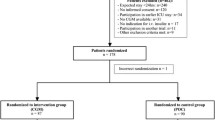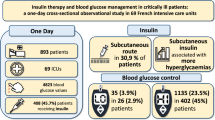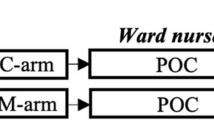Abstract
Objective
To lower glucose levels in all patients in the intensive care unit (ICU) to the target range of 4.5–7.5 mmol/l using a nurse-driven computerised insulin protocol in combination with bedside glucose measurement.
Design
Cohort study.
Setting
Mixed adult ICU.
Patients and participants
All 182 patients admitted to the ICU during a 3-month period were studied, except for 3 patients admitted for diabetic keto-acidosis.
Interventions
Five steps were taken to improve glucose regulation: (1) Nurses were authorised to adjust insulin dosage using a protocol. (2) Glucose was measured more often. (3) Glucose was measured at the bedside. (4) Consecutive protocols aimed for successively lower glucose levels; the final protocol had a target range of 4.5–7.5 mmol/l. (5) The protocol was computerised.
Measurements and result
Mean glucose decreased from 9.23 mmol/l without protocol to 7.68 mmol/l with the final protocol. This final protocol with the target of 4.5–7.5 mmol/l was evaluated more extensively. Glucose levels were measured a total of 1854 times in 179 ICU admissions during 552 ICU treatment days. The median glucose level was 7.0 mmol/l, and 53.1% of glucose measurements were within the target range of 4.5–7.5 mmol/l. One episode of hypoglycaemia (glucose ≤ 2.2 mmol/l) occurred, representing 0.5% of patients or 0.05% of glucose measurements.
Conclusions
The combined strategy of successively more ambitious nurse-driven (computerised) insulin protocols and bedside glucose measurement resulted in acceptably low glucose levels with very few episodes of hypoglycaemia.

Similar content being viewed by others
References
van den Berghe G, Wilmer A, Hermans G, Meersseman W, Wouters PJ, Milants I, Van Wijngaerden E, Bobbaers H, Bouillon R (2006) Intensive insulin therapy in the medical ICU. N Engl J Med 354:449–461
van den Berghe G, Wouters P, Weekers F, Verwaest C, Bruyninckx F, Schetz M, Vlasselaers D, Ferdinande P, Lauwers P, Bouillon R (2001) Intensive insulin therapy in the critically ill patients. N Engl J Med 345:1359–1367
Finney SJ, Zekveld C, Elia A, Evans TW (2003) Glucose control and mortality in critically ill patients. JAMA 290:2041–2047
Krinsley JS (2004) Effect of an intensive glucose management protocol on the mortality of critically ill adult patients. Mayo Clin Proc 79:992–1000
Dellinger RP, Carlet JM, Masur H, Gerlach H, Calandra T, Cohen J, Gea-Banacloche J, Keh D, Marshall JC, Parker MM, Ramsay G, Zimmerman JL, Vincent JL, Levy MM (2004) Surviving Sepsis Campaign guidelines for management of severe sepsis and septic shock. Crit Care Med 32:858–873
Malhotra A (2006) Intensive insulin in intensive care. N Engl J Med 354:516–518
Watkinson P, Barber VS, Young JD (2006) Strict glucose control in the critically ill. BMJ 332:865–866
Brown G, Dodek P (2001) Intravenous insulin nomogram improves blood glucose control in the critically ill. Crit Care Med 29:1714–1719
Collier B, Diaz J, Jr., Forbes R, Morris J, Jr., May A, Guy J, Ozdas A, Dupont W, Miller R, Jensen G (2005) The impact of a normoglycemic management protocol on clinical outcomes in the trauma intensive care unit. J Parenter Enteral Nutr 29:353–358
Dilkhush D, Lannigan J, Pedroff T, Riddle A, Tittle M (2005) Insulin infusion protocol for critical care units. Am J Health Syst Pharm 62:2260–2264
Goldberg PA, Sakharova OV, Barrett PW, Falko LN, Roussel MG, Bak L, Blake-Holmes D, Marieb NJ, Inzucchi SE (2004) Improving glycemic control in the cardiothoracic intensive care unit: clinical experience in two hospital settings. J Cardiothorac Vasc Anesth 18:690–697
Goldberg PA, Siegel MD, Sherwin RS, Halickman JI, Lee M, Bailey VA, Lee SL, Dziura JD, Inzucchi SE (2004) Implementation of a safe and effective insulin infusion protocol in a medical intensive care unit. Diabetes Care 27:461–467
Kanji S, Singh A, Tierney M, Meggison H, McIntyre L, Hebert PC (2004) Standardization of intravenous insulin therapy improves the efficiency and safety of blood glucose control in critically ill adults. Intensive Care Med 30:804–810
Taylor BE, Schallom ME, Sona CS, Buchman TG, Boyle WA, Mazuski JE, Schuerer DE, Thomas JM, Kaiser C, Huey WY, Ward MR, Zack JE, Coopersmith CM (2006) Efficacy and safety of an insulin infusion protocol in a surgical ICU. J Am Coll Surg 202:1–9
Zimmerman CR, Mlynarek ME, Jordan JA, Rajda CA, Horst HM (2004) An insulin infusion protocol in critically ill cardiothoracic surgery patients. Ann Pharmacother 38:1123–1129
Vogelzang M, van der Horst IC, Nijsten MW (2004) Hyperglycaemic index as a tool to assess glucose control: a retrospective study. Crit Care 8:R122–127
van den Berghe G (2004) How to compare adequacy of algorithms to control blood glucose in the intensive care unit? Crit Care 8:151–152
Kanji S, Buffie J, Hutton B, Bunting PS, Singh A, McDonald K, Fergusson D, McIntyre LA, Hebert PC (2005) Reliability of point-of-care testing for glucose measurement in critically ill adults. Crit Care Med 33:2778–2785
Brunkhorst FM KE, Engel C, et al. (2005) Intensive insulin therapy in patient with severe sepsis and septic shock is associated with an increased rate of hypoglycemia – results from a randomized multicenter study (VISEP). Infection 33:19–20
Author information
Authors and Affiliations
Corresponding author
Additional information
This article is discussed in the editorial available at: http://dx.doi.org/10.1007/s00134-006-0485-y.
Rights and permissions
About this article
Cite this article
Meynaar, I.A., Dawson, L., Tangkau, P.L. et al. Introduction and evaluation of a computerised insulin protocol. Intensive Care Med 33, 591–596 (2007). https://doi.org/10.1007/s00134-006-0484-z
Received:
Accepted:
Published:
Issue Date:
DOI: https://doi.org/10.1007/s00134-006-0484-z




